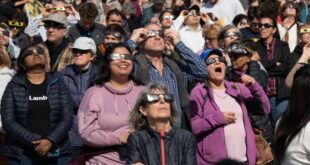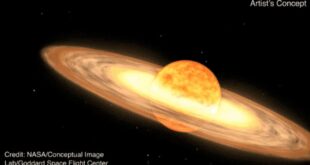Scientists believe the impact from a giant space rock formed the ‘Eye of Quebec.’

I love it when people say, “Once you see it, you can never unsee it.”
One example is what’s been called the “Eye of Quebec.” You might have never noticed it when looking at a satellite image of the province. Look north, near the border with Labrador. Do you see it? What the heck is that?
It’s the Manicouagan Reservoir, believed to be caused by a crater formed a full 214 million years ago, (wow) when an asteroid hit the Earth in the Late Triassic period. How big was the space rock that hit Earth about 315 kilometres north of Baie-Comeau?
Oh not that big, really, just a full six kilometres in diameter.
The passing of glaciers and erosion wore away the 100-kilometre-diameter crater, but looking down on it from a bird’s eye view, the “eye” is impossible to unsee. There’s basically this circular lake that makes the centre island appear dry, kind of as if there’s a moat surrounding the impact area.
And scientists believe it was not the only crater formed at the time of impact.
The Manicouagan crater may have been part of a multiple-impact event which also formed the Rochechouart impact structure in France, the Saint Martin crater in Manitoba, the Obolon crater in Ukraine and the Red Wing crater in North Dakota.
David Rowley, a geophysicist with the University of Chicago, working with John Spray of the University of New Brunswick and Simon Kelley of the Open University discovered that the five craters appeared to form a chain, indicating the breakup and subsequent impact of an asteroid or comet, similar to the well-observed string of impacts of Comet Shoemaker–Levy 9 on Jupiter in 1994.

Are you interested in visiting the Eye of Quebec? I certainly am.
There are a few little settlements of structures along the eastern edge of the lake that form the eye, for example Relais-Gabriel. You’ll find the odd outfitter along Lac Manicougan — and if you keep driving along Highway 389 for another 270 kilometres, you’ll hit the bustling metropolis of Labrador City, just to give you an idea of how rural we are talking here.
Be sure to stop in at the Pourvoirie Relais-Gabriel, which Google Maps tells me is a rest stop and restaurant where you can get a nice burger. The listing says you can dine in or take out, but no delivery is available, ha!
While this particular crater and corresponding reservoir were formed millions of years ago, different kinds of meteor-type things are entering our atmosphere all the time. The Maine Mineral and Gem Museum recently made big news across the Maritimes by offering $25,000 US to anyone who can produce elements of whatever “space rock” came to Earth on the mile-wide “strewn field” that stretches from just north of Waite, Maine, to Canoose, N.B. And the mineral museum is encouraging people to go exploring.
It has created a bit of a space-rock rush in the eastern portion of New Brunswick, not unlike the Klondike Gold Rush that took the Yukon by storm.
OK, I jest. But $25,000 US is nothing to shake a stick at! Anyway, I love it. Do we have the next Eye of Quebec forming sometime soon? Perhaps an Eye of Ontario or Eye of Nova Scotia? That might be pretty exciting, but it would be equally catastrophic. So while it’s not something to hope for, keep your eyes on the sky!
This story was produced by John Batt as part of the CBC Creator Network. Learn more about the Creator Network here.
ABOUT THE AUTHOR

Freelance contributor
John Batt was born and raised in Fredericton and now lives in Montreal. He is the administrator behind the popular Canadian history-themed Instagram account @canada.gov.ca. When Batt is not working in post-secondary education, he is fine-tuning his live show that is coming to a city near you.
*****
Credit belongs to : www.cbc.ca
 Atin Ito First Filipino Community Newspaper in Ontario
Atin Ito First Filipino Community Newspaper in Ontario






